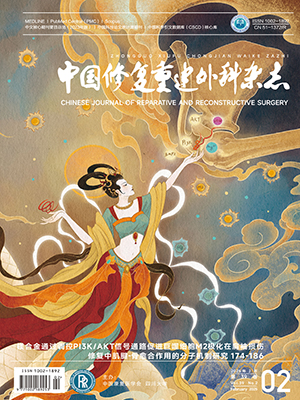| 1. |
Teuschl AH, Nürnberger S, Redl H, et al. Articular cartilage tissue regeneration-current research strategies and outlook for the future. Eur Surg, 2013, 45(3):142-153.
|
| 2. |
Huey DJ, Hu JC, Athanasiou KA. Unlike bone, cartilage regeneration remains elusive. Science, 2012, 338(6109):917-921.
|
| 3. |
Mahmoudifar N, Doran PM. Chondrogenesis and cartilage tissue engineering:the longer road to technology development. Trends in Biotechnology, 2012, 30(3):166-176.
|
| 4. |
Madry H, van Dijk C, Mueller-Gerbl M. The basic science of the subchondral bone. Knee Surg Sports Traumatol Arthrosc, 2010, 18(4):419-433.
|
| 5. |
Gomoll AH, Madry H, Knutsen G, et al. The subchondral bone in articular cartilage repair:current problems in the surgical management. Knee Surg Sports Traumatol Arthrosc, 2010, 18(4):434-447.
|
| 6. |
National Research Council. Guide for the Care and Use of Laboratory Animals:Eighth Edition. Washington DC:National Academies Press, 2011:11-151.
|
| 7. |
Bian W, Li D, Lian Q, et al. Fabrication of a bio-inspired beta-Tricalcium phosphate/collagen scaffold based on ceramic stereolithography and gel casting for osteochondral tissue engineering. Rapid Prototyping Journal, 2012, 18(1):68-80.
|
| 8. |
Li X, Li D, Wang L, et al. Osteoblast cell response to beta-tricalcium phosphate scaffolds with controlled architecture in flow perfusionculture system. J Mater Sci Mater Med, 2008, 19(7):2691-2697.
|
| 9. |
朱林重, 连芩, 靳忠民, 等. PEGDA 水凝胶的光固化成形工艺及其性能评价. 西安交通大学学报, 2012, 46(10):121-126.
|
| 10. |
Wayne JS, McDowell CL, Shields KJ, et al. In vivo response of polylactic acid-alginate scaffolds and bone marrow-derived cells for cartilage tissueengineering. Tissue Eng, 2005, 11(5-6):953-963.
|
| 11. |
Zaslav K, McAdams T, Scopp J, et al. New frontiers for cartilage repair and protection. Cartilage, 2012, 3(1 Suppl):77S-86S.
|
| 12. |
Hoemann CD, Lafantaisie-Favreau CH, Lascau-Coman V, et al. The cartilage-bone interface. J Knee Surg, 2012, 25(2):85-97.
|
| 13. |
Lories RJ, Luyten FP. The bone-cartilage unit in osteoarthritis. Nat Rev Rheumatol, 2010, 7(1):43-49.
|
| 14. |
Orth P, Cucchiarini M, Kaul G, et al. Temporal and spatial migration pattern of the subchondral bone plate in a rabbit osteochondral defect model. Osteoarthritis Cartilage, 2012, 20(10):1161-1169.
|
| 15. |
Bellido M, Lugo L, Roman-Blas JA, et al. Improving subchondral bone integrity reduces progression of cartilage damage in experimental osteoarthritispreceded by osteoporosis. Osteoarthritis and Cartilage, 2011, 19(10):1228-1236.
|
| 16. |
王富友, 杨柳, 段小军, 等. 正常膝关节软骨钙化层形态结构研究. 中国修复重建外科杂志, 2008, 27(5):524-527.
|
| 17. |
付鑫, 马剑雄, 董宝康, 等. 骨微结构检测方法研究进展. 中国骨与关节外科, 2009, 2(6):509-514.
|
| 18. |
徐健, 何威奇, 曾宪敏. 骨质疏松骨微结构的影像学研究进展. 华西医学, 2008, 23(3):675-676.
|
| 19. |
Funck-Brentano T, Lin H, Hay E, et al. Targeting bone alleviates osteoarthritis in osteopenic mice and modulates cartilage catabolism. PloS One, 2012, 7(3):e33543.
|
| 20. |
Cox LG, van Donkelaar CC, van Rietbergen B, et al. Alterations to the subchondral bone architecture during osteoarthritis:bone adaptation vs endochondral boneformation. Osteoarthritis Cartilage, 2013, 21(2):331-338.
|
| 21. |
Vasara AI, Hyttinen MM, Lammi MJ, et al. Subchondral bone reaction associated with chondral defect and attempted cartilage repair in goats. Calcif Tissue Int, 2004, 74(1):107-114.
|
| 22. |
Jackson DW, Lalor PA, Aberman HM, et al. Spontaneous repair of full-thickness defects of articular cartilage in a goat model. A preliminary study. J Bone Joint Surg (Am), 2001, 83(1):53-64.
|
| 23. |
Schlichting K, Schell H, Kleemann RU, et al. Influence of scaffold stiffness on subchondral bone and subsequent cartilage regeneration in an ovine model of osteochondral defect healing. Am J Sports Med, 2008, 36(12):2379-2391.
|
| 24. |
Chen H, Chevrier A, Hoemann CD, et al. Characterization of subchondral bone repair for marrow-stimulated chondral defects and its relationship to articular cartilage resurfacing. Am J Sports Med, 2011, 39(8):1731-1740.
|
| 25. |
Chevrier A, Hoemann CD, Sun J, et al. Chitosan-glycerol phosphate/blood implants increase cell recruitment, transient vascularization and subchondralbone remodeling in drilled cartilage defects. Osteoarthritis Cartilage, 2007, 15(3):316-327.
|
| 26. |
Hoemann CD, Sun J, McKee MD, et al. Chitosan-glycerol phosphate/blood implants elicit hyaline cartilage repair integrated with porous subchondralbone in microdrilled rabbit defects. Osteoarthritis Cartilage, 2007, 15(1):78-89.
|
| 27. |
Marchand C, Chen G, Tran-Khanh N, et al. Microdrilled cartilage defects treated with thrombin-solidified chitosan/blood implant regenerate a more hyaline, stable, and structurally integrated osteochondral unit compared to drilled controls. Tissue Eng Part A, 2012, 18(5-6):508-519.
|




